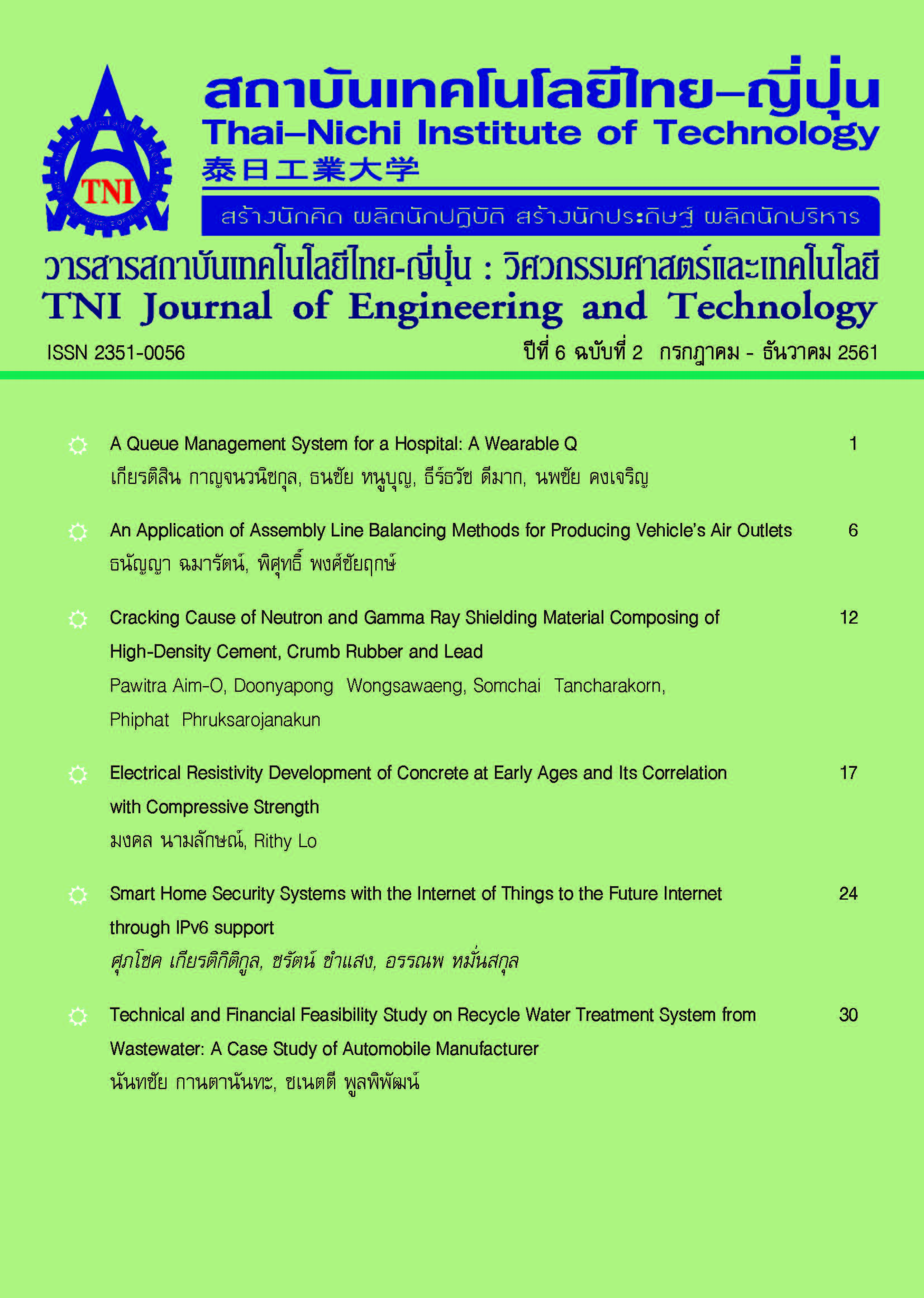Cracking Cause of Neutron and Gamma Ray Shielding Material Composing of High-Density Cement, Crumb Rubber and Lead
Main Article Content
บทคัดย่อ
The cause of the crack under neutron and photon flux of neutron and gamma ray shielding material composing of high-density cement mixed with 5% waste rubber and various percentages of lead powder was investigated. This shielding material was designed and fabricated in our prior work to shield against radiation from synchrotron accelerator. The lead percentages of 2, 4, 6 and 8 wt.% were studied. It was found that with the lead content of at least 4 wt.%, the shielding material cracked under neutron and gamma-ray irradiation. The crystalline phases as well as elemental composition of the shielding material were determined by quantitative X-ray diffraction technique (QXRD). Results revealed the following crystalline phases: barite, portlandite, quartz, calcite, lead and PbO2. Experimental tests were performed to determine the physical bonding of lead power to high-density cement. Results revealed that lead powder exhibited very weak adhesion to the cement, indicating that the poor mechanical interface was the underlying cause of cracking. These data will be helpful in developing this class of radiation shielding material to prevent the cracking problem.
Article Details
นโยบายการรับบทความ
กองบรรณาธิการวารสารสถาบันเทคโนโลยีไทย-ญี่ปุ่น มีความยินดีรับบทความจากอาจารย์ประจำ และผู้ทรงคุณวุฒิในสาขาวิศวกรรมศาสตร์และเทคโนโลยี ที่เขียนเป็นภาษาไทยหรือภาษาอังกฤษ ซึ่งผลงานวิชาการที่ส่งมาขอตีพิมพ์ต้องไม่เคยเผยแพร่ในสิ่งพิมพ์อื่นใดมาก่อน และต้องไม่อยู่ในระหว่างการพิจารณาของวารสารอื่นที่นำส่ง ดังนั้นผู้สนใจที่จะร่วมเผยแพร่ผลงานและความรู้ที่ศึกษามาสามารถนำส่งบทความได้ที่กองบรรณาธิการเพื่อเสนอต่อคณะกรรมการกลั่นกรองบทความพิจารณาจัดพิมพ์ในวารสารต่อไป ทั้งนี้บทความที่สามารถเผยแพร่ได้ประกอบด้วยบทความวิจัย ผู้สนใจสามารถศึกษาและจัดเตรียมบทความจากคำแนะนำสำหรับผู้เขียนบทความ
การละเมิดลิขสิทธิ์ถือเป็นความรับผิดชอบของผู้ส่งบทความโดยตรง บทความที่ได้รับการตีพิมพ์ต้องผ่านการพิจารณากลั่นกรองคุณภาพจากผู้ทรงคุณวุฒิและได้รับความเห็นชอบจากกองบรรณาธิการ
ข้อความที่ปรากฏภายในบทความของแต่ละบทความที่ตีพิมพ์ในวารสารวิชาการเล่มนี้ เป็น ความคิดเห็นส่วนตัวของผู้เขียนแต่ละท่าน ไม่เกี่ยวข้องกับสถาบันเทคโนโลยีไทย-ญี่ปุ่น และคณาจารย์ท่านอื่น ๆ ในสถาบัน แต่อย่างใด ความรับผิดชอบด้านเนื้อหาและการตรวจร่างบทความแต่ละบทความเป็นของผู้เขียนแต่ละท่าน หากมีความผิดพลาดใด ๆ ผู้เขียนแต่ละท่านจะต้องรับผิดชอบบทความของตนเองแต่ผู้เดียว
กองบรรณาธิการขอสงวนสิทธิ์มิให้นำเนื้อหา ทัศนะ หรือข้อคิดเห็นใด ๆ ของบทความในวารสารสถาบันเทคโนโลยีไทย-ญี่ปุ่น ไปเผยแพร่ก่อนได้รับอนุญาตจากผู้นิพนธ์ อย่างเป็นลายลักษณ์อักษร ผลงานที่ได้รับการตีพิมพ์ถือเป็นลิขสิทธิ์ของวารสารสถาบันเทคโนโลยีไทย-ญี่ปุ่น
ผู้ประสงค์จะส่งบทความเพื่อตีพิมพ์ในวารสารวิชาการ สถาบันเทคโนโลยีไทย-ญี่ปุ่น สามารถส่ง Online ที่ https://www.tci-thaijo.org/index.php/TNIJournal/ โปรดสมัครสมาชิก (Register) โดยกรอกรายละเอียดให้ครบถ้วนหากต้องการสอบถามข้อมูลเพิ่มเติมที่
- กองบรรณาธิการ วารสารสถาบันเทคโนโลยีไทย-ญี่ปุ่น
- ฝ่ายวิจัยและนวัตกรรม สถาบันเทคโนโลยีไทย-ญี่ปุ่น
เลขที่ 1771/1 สถาบันเทคโนโลยีไทย-ญี่ปุ่น ซอยพัฒนาการ 37-39 ถนนพัฒนาการ แขวงสวนหลวง เขตสวนหลวง กรุงเทพมหานคร 10250 ติดต่อกับคุณพิมพ์รต พิพัฒนกุล (02) 763-2752 , คุณจุฑามาศ ประสพสันติ์ (02) 763-2600 Ext. 2402 Fax. (02) 763-2754 หรือ E-mail: JEDT@tni.ac.th
เอกสารอ้างอิง
R. Picha et al., “Gamma and neutron attenuation properties of barite-cement mixture,” Journal of Physics: Conference Series, vol. 611, no. 1, p. 012002, 2015.
S. Sharifi, R. Bagheri, and S. P. Shirmardi, “Comparison of shielding properties for ordinary, barite, serpentine and steel–magnetite concretes using MCNP-4C code and available experimental results,” Annals of Nuclear Energy, vol. 53, pp. 529–534, Mar. 2013.
D. Sarıyer, R. Küçer, and N. Küçer, “Neutron Shielding Properties of Concretes Containing Boron Carbide and Ferro – Boron,” Procedia - Social and Behavioral Sciences, vol. 195, pp. 1752–1756, Jul. 2015.
D. McAlister, Gamma Ray Attenuation Properties of Common Shielding Materials. USA: University Lane Lisle, 2013.
I. Akkurt, H. Akyildirim, B. Mavi, S. Kilincarslan, and C. Basyigit, “Gamma-ray shielding properties of concrete including barite at different energies,” Progress in Nuclear Energy, vol. 52, no. 7, pp. 620–623, Sep. 2010.
H. Hu et al., “Study on Composite Material for Shielding Mixed Neutron andγ-Rays,” IEEE Transactions on Nuclear Science, vol. 55, no. 4, pp. 2376–2384, Aug. 2008.
K.M Kotresh and M. Belachew, "Study On Waste Tyre Rubber As Concrete Aggregates", International Journal of Scientific Engineering and Technology, vol.3, no.4, pp. 433-436, 2014.
C. Jumpee and D. Wongsawaeng, “Innovative neutron shielding materials composed of natural rubber-styrene butadiene rubber blends, boron oxide and iron(III) oxide,” Journal of Physics: Conference Series, vol. 611, no. 1, p. 012019, 2015.
P. Aim-O, D. Wongsawaeng, S. Tancharakorn, P.Phruksarojanakun (inpress), " Monte carlo simulation of innovative neutron and photon shielding material composing of high density concrete, waste rubber, lead and boron carbide,"Journal of Physics: Conference Series by IOP Publishing Ltd.


